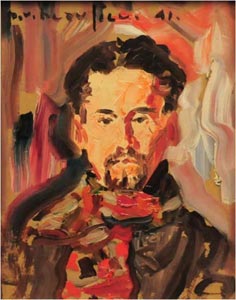
Jean Dallaire by P.V. Beaulieu in 1941
BIOGRAPHY
Born into a large family in Hull, Quebec, Jean-Philippe Dallaire studied art in Toronto, Montreal and Paris, yet was generally self-taught, too independent of spirit to associate with any particular group or adhere to one specific style.
His stay in Paris, a de rigueur visit for most Quebec artists, was marked by encounters with the art of Picasso and the surrealists but ended with an arrest by the Gestapo in 1940. Dallaire spent the next four years in a detention camp. He continued to draw, he even learned Italian. Back in Canada he was drawn to teaching, and spent many years illustrating educational films for the National Film Board.
Dallaire was essentially impervious to trends and critique, gently charting his own unique patch, and the last word on his art has yet to be spoken.
His work has gone through many changes, as the 20th century took shape. Realistic portraits mark the early years, followed by experiments in cubism and surrealism, but always filtered, altered by Dallaire’s peculiar way of seeing the world.
A sense of the theatrical, an atmosphere of a carnival, permeate most of his works, an inescapable, tickling presence of another reality.
SUBJECT / THEMES
“One could say that I do not take life seriously. I always had a fondness for birds, little flags and the texture of fabrics. Perhaps it is a bit decorative, but so what.”, Dallaire is quoted as saying in 1957.
This unpretentious self-analysis defies the plastic genius of his work, the attention to quality and draftsmanship, the boldly subtle choice of colours and the magical way in which they fill every inch of the canvas.
Echoes of surrealism can be found in his floating compositions, the unusual pairing of figures, at once realistic and theatrical. But unlike de Chirico’s metaphysical stillness or Dali’s fantastical creations, Dallaire’s works accentuate the pictorial rather than the intellectual. Like the Surrealists, he is in search of Virgin territories, but his flights of fancy are disarmingly human, almost childlike.
Dallaire, although aware of the major currents in art, was staunchly original, creating his own fantasy-based universe, unapologetic about his fascination with theatre in all its forms, from drama to puppetry.
His cubist period produced magnificent still lifes, incorporating his beloved birds in one monochromatic composition which echoes of Braque, or focusing on a pair of fruit rendered in bold colour and rich texture.
Eclectic, quietly emotional, Dallaire was a lonely pilgrim in a world exploring with new ideas and visual experimentation.
Could it be that Dallaire sought to forget the hardship he experienced in the simple joy of paintings his beloved birds, in losing himself in playful portraits composed of dappled patches of colour, faces staring at the viewer with childlike surprise, all adorned with fancy hats and tiny umbrellas.
But while the rest of the world was gasping at the avant-garde works of Rothko, Pollock and Bacon, Dallaire continued on his own path, securely ensconced in his magical universe.
This very personal manner of constructing his own pictorial universe sets Dallaire apart from other contemporary artists of his day. This expressive expansiveness of his imagery is unlike any other, and although it reflects numerous influences, it remains unique, and highly mastered.
TECHNIQUE/MEDIUM
Dallaire had a magical way of applying paint. His oils look like gouaches, the texture of the board, or canvas, visible under the fine layers of paint. As simple as the image may appear, it is in fact a symphony of colour and gesture, a painterly tableau in the guise of a fairytale.
Each glance at Dallaire work reveals something new.
EXHIBITION
“Jean Dallaire. Retrospective exhibition”, October 18 to November 8, 2008, Galerie Valentin
From a text by Dorota Kozinska for Galerie Valentin